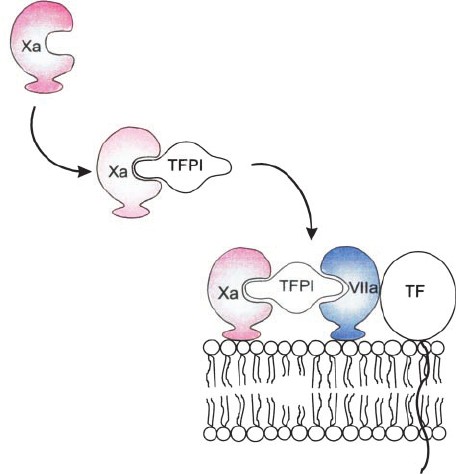What is TFPI Protein?
Tissue factor pathway inhibitor (TFPI) is a multifaceted, endogenous protein involved in the regulation of blood coagulation, critically swim in the sophisticated network of hemostasis. The TFPI protein was initially identified by Broze and Miletich in 1984, after extensive experimentation and characterized in sub-sequential years. Their research laid grounds for understanding the complex interplay between clot-promoting and -limiting factors.
The TFPI gene is situated at 2q32.2 locus of humans' genome. The gene, which spans around 87 kilo base pairs, consists of nine exons, differentially employed to give rise to three TFPI protein isoforms, namely TFPIα, TFPIβ, and TFPIγ. The protein structure varies across these isoforms, with domains exhibiting differential bindings to tissue factor and factor Xa, vital for regulating coagulation.
Function of TFPI Protein
In the bloodstream, TFPI functions primarily as a coagulation inhibitor. Upon initiation of blood coagulation - a biological process that prevents excessive bleeding after injuries - a protein named tissue factor (TF) forms a complex with Factor VIIa. This TF-FVIIa complex triggers a cascading series of reactions, which ultimately cause the blood to clot.
TFPI interrupts this process by binding with the TF-FVIIa complex, thereby inhibiting further clotting. TFPI first binds to Factor Xa, forming a TFPI-FXa complex that subsequently binds to and inactivates the TF-FVIIa complex. This dual-inhibitory action, constituting first a rapid and then slow phase, reflects a function tuned for efficiency and control.

Fig1. Mechanism of action of TFPI
TFPI Protein Related Signal Pathway
The TFPI protein is central to an intricate network of signaling pathways, prominent among them being the tissue-factor driven thrombin formation. Tissue factor (TF), a cellular initiator of blood clotting, works in tandem with Factor VIIa and Xa. The TF-FVIIa complex activates Factor X to Factor Xa, which generates thrombin - a key player in clot formation.
However, TFPI interrupts this pathway, binding to Factor Xa in the primary phase and to the TF-FVIIa complex in the secondary phase. Consequently, it prevents further thrombin generation, an action pivotal to its overall function of controlling excessive blood clot formation.
TFPI Protein Related Diseases
Abnormal levels of TFPI protein, either overexpression or deficiency, are associated with various diseases, notably concerning blood-clotting disorders. A heightened risk of thrombosis, a condition where blood clots form in blood vessels, is linked to reduced TFPI levels. Conversely, excess TFPI leads to bleeding disorders due to inhibitory effects on clotting.
Besides, recent studies have linked dysregulated TFPI with cancer progression - while the protein generally prevents cancer's pro-coagulant status, certain cancer types seem to override this inhibitory effect, using TFPI to their advantage and fostering metastasis.
TFPI Protein's Applications in Biomedicine
Given its central role in hemostasis, TFPI protein has numerous potential applications in biomedicine. It is evolving as a promising therapeutic agent in managing blood clotting disorders, particularly thrombosis, where TFPI mimetics are used to regulate clot formation.
Moreover, the recent understanding about the interplay between cancer and TFPI has opened new avenues in cancer therapy, where strategies to disrupt the malignant use of TFPI could possibly impede cancer progression.
Furthermore, as a biomarker, TFPI serves in the diagnosis and prognosis of diseases involving blood clotting, particularly in monitoring the effectiveness of anticoagulant treatment.
In conclusion, TFPI protein, with its multi-layered function, has an elemental role in the characteristics of coagulation and is involved in the pathologies of numerous diseases. Its immense potential in the field of biomedicine highlights the importance of further research to unlock its full therapeutic potential.
Our Featured Products
| Cat.No. | Product Name | Species | Source (Host) | Tag |
|---|---|---|---|---|
| TFPI-875H | Active Recombinant Human TFPI protein, His-tagged | Human | HEK293 | His |
| TFPI-106H | Recombinant Human TFPI protein, His/GST-tagged | Human | E.coli | His/GST |
| TFPI-646HB | Recombinant Human TFPI protein, His-Avi-tagged, Biotinylated | Human | HEK293 | His-Avi |
| TFPI-751H | Recombinant Human TFPI Protein, Biotinylated | Human | HEK293 | |
| TFPI-876H | Recombinant Human TFPI protein, His-tagged, Biotinylated | Human | HEK293 | His |
| Tfpi-981M | Active Recombinant Mouse Tfpi Protein, His-tagged | Mouse | Mammalian cells | His |
| Tfpi-9155M | Recombinant Mouse Tfpi Protein, His (Fc)-Avi-tagged | Mouse | HEK293 | His (Fc)-Avi |
Reference
- Hirsh, Jack & Samama, Meyer. (2004). New anticoagulant drugs: the Seventh ACCP Conference on Antithrombotic and Thrombolytic Therapy. Chest. 126. 265S-286S. 10.1378/chest.126.3_suppl.265S.

